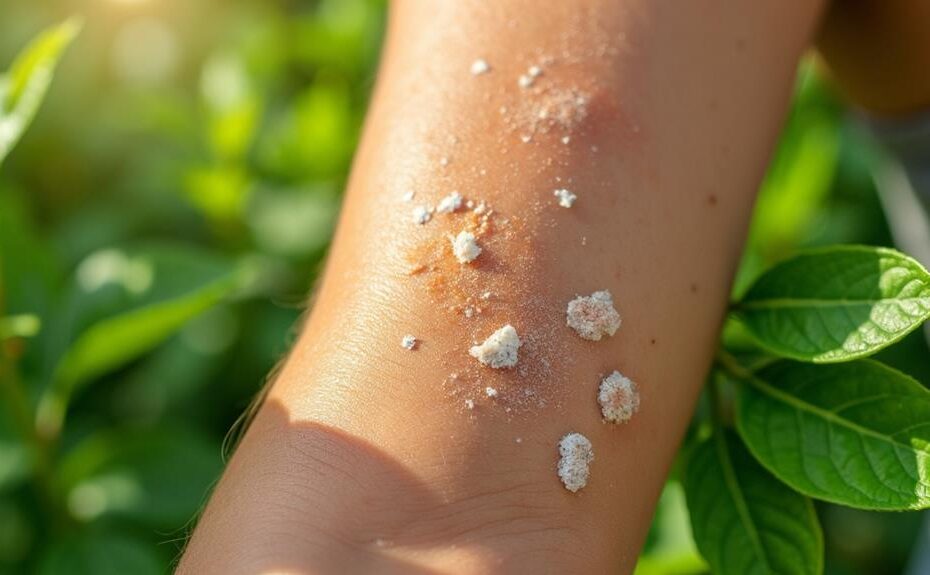







Yes, Vitamin B3 deficiency can lead to serious skin disorders, primarily dermatitis, known as pellagra. When you lack niacin, your skin may develop thick, scaly rashes, especially in sun-exposed areas. This can worsen over time, leading to further complications like glossitis and stomatitis. Diets low in protein, gastrointestinal diseases, or excessive alcohol consumption increase your risk. Recognizing these symptoms early can greatly improve your skin health with timely intervention. If you're curious about the complexities of this condition and ways to manage it, there's more to discover about its effects and prevention strategies.
Key Takeaways
- Vitamin B3 deficiency can lead to pellagra, a condition characterized by dermatitis, diarrhea, and dementia.
- Dermatitis from niacin deficiency presents as thick, scaly rashes that worsen with sun exposure.
- Other skin-related complications include glossitis and stomatitis, which can affect overall skin health.
- Diets lacking in niacin-rich foods increase the risk of deficiency and associated skin disorders.
- Early recognition and treatment of niacin deficiency can improve skin conditions and prevent progression.
Understanding Vitamin B3
Understanding Vitamin B3
Vitamin B3, frequently referred to as niacin, plays an essential role in maintaining skin health and overall well-being. This significant nutrient is involved in DNA repair and the metabolism of fats, proteins, and carbohydrates, making it critical for your body's functioning. Additionally, vitamin B3 boosts skin health through its anti-inflammatory properties, which can help calm skin conditions. A deficiency in vitamin B3 can lead to pellagra, a condition characterized by dermatitis, which manifests as thick, scaly rashes on sun-exposed areas of your skin.
When you don't get enough niacin, you may experience symptoms like erythematous bullous changes and acute inflammation, indicating considerable damage to your skin's structure. Pellagra dermatitis can worsen with sun exposure, underscoring the significance of adequate niacin intake to protect your skin from UV damage.
To prevent such deficiencies, you should be aware of the recommended daily allowance (RDA) for niacin: 16 mg for men and 14 mg for women. This emphasizes the need for sufficient dietary intake of vitamin B3 through foods like meat, fish, and whole grains. By ensuring you meet these requirements, you can help maintain your skin's health and prevent disorders linked to niacin deficiency.
Skin Disorders Linked to Deficiency
A deficiency in niacin can lead to considerable skin disorders, with pellagra being the most notable. This niacin deficiency condition is characterized by severe dermatitis, often presenting as thick, scaly rashes on areas of your skin exposed to sunlight. Pellagra dermatitis involves erythematous bullous changes and acute inflammation, causing degeneration of the skin's outer layer (stratum corneum). Additionally, niacinamide, the active form of vitamin B3, has been shown to support skin barrier function and hydration, which can be particularly beneficial for those suffering from skin conditions related to deficiency improved skin conditions.
You might also experience glossitis and stomatitis, which are inflammatory conditions affecting your mouth and tongue, further complicating skin health issues. Individuals at heightened risk for these skin disorders typically have diets low in protein and niacin, particularly those relying on corn-based diets that diminish niacin bioavailability.
Recognizing niacin deficiency early is essential, as timely intervention can notably improve your skin's condition. Niacin supplementation often leads to symptom resolution within weeks, helping restore your skin's integrity and overall health. Addressing dietary inadequacies is vital for preventing these skin disorders and promoting a healthier lifestyle. By understanding the connection between niacin deficiency and skin health, you can make informed decisions about your nutritional intake and overall well-being.
Symptoms of Niacin Deficiency
When niacin deficiency occurs, its symptoms can considerably impact your overall health. This condition, known as pellagra, is marked by the classic trio of dermatitis, diarrhea, and dementia. Dermatitis typically presents as thick, scaly rashes on areas of your skin exposed to the sun, often leading to severe skin lesions that worsen with additional sun exposure. The inflammation can cause erythematous bullous changes, resulting in further degeneration of the stratum corneum. Additionally, niacin is crucial for maintaining skin health and supporting the skin barrier, making its deficiency particularly concerning for skin integrity and appearance the health benefits of niacin.
Another significant symptom is glossitis, characterized by a swollen, bright red tongue accompanied by mouth sores and stomatitis. Early signs of niacin deficiency may include fatigue and mood changes, which, if not addressed, can escalate into more severe cognitive effects. It is vital to recognize these symptoms early on, as they reflect broader systemic impacts of niacin deficiency.
Ignoring these signs can lead to a decline in your overall well-being, highlighting the importance of ensuring adequate vitamin B3 intake. Addressing niacin deficiency promptly can prevent further complications and improve your quality of life.
Causes and Risk Factors
Niacin deficiency leads to a host of health issues, particularly skin disorders like pellagra. This condition manifests through dermatitis, especially on sun-exposed areas, resulting in thick, scaly rashes and erythematous bullous changes. Your diet plays an essential role in niacin levels; those consuming corn-based diets with low protein are at greater risk for deficiency. Corn contains niacin, but its bioavailability is low, making it less effective in preventing pellagra.
Additionally, certain gastrointestinal diseases can hinder the absorption of niacin and its precursor, tryptophan, further exacerbating the risk of skin disorders. Alcoholism also impairs absorption, increasing susceptibility to symptoms associated with niacin deficiency. Populations in developing countries, particularly in regions like sub-Saharan Africa and parts of India, face heightened risk due to reliance on corn-based diets, often lacking essential nutrients.
To mitigate these risks, it's important to guarantee a balanced diet rich in vitamin B3 sources, such as meat, fish, and fortified foods. Awareness of these causes and risk factors can help you take proactive steps to maintain ideal skin health and overall well-being.
Diagnosis and Testing
Diagnosing vitamin B3 deficiency requires a detailed evaluation of clinical symptoms alongside specific laboratory tests. You'll typically look for the hallmark symptoms of pellagra, which include dermatitis, diarrhea, and dementia—often referred to as the three Ds. To confirm the diagnosis, laboratory testing plays a vital role. One effective method is examining urinary excretion of N1-methylnicotinamide; levels below 5.8 micromoles strongly indicate niacin deficiency.
Skin biopsies can also be performed, as they might reveal characteristic changes associated with pellagra dermatitis, though they aren't definitive for diagnosis. A rapid clinical response to niacin supplementation within a week can further reinforce the diagnosis of deficiency.
For certain conditions, such as Hartnup disease, testing for elevated neutral amino acids in urine can assist in identifying impaired niacin synthesis and absorption. This all-encompassing approach to diagnosis guarantees that you're not just relying on symptoms but also on quantitative measures that validate the presence of deficiency. Understanding these diagnostic tools is essential for accurately identifying vitamin B3 deficiency and its potential impact on skin health.
Treatment and Management
Recognizing vitamin B3 deficiency is just the first step; effective treatment and management are essential for alleviating the associated skin disorders like pellagra dermatitis. The primary approach involves oral supplementation of niacin, specifically nicotinamide, at doses ranging from 250 to 500 mg daily. This regimen typically leads to rapid symptom improvement.
For long-term management, a balanced diet rich in dietary sources of niacin, such as red meat, fish, poultry, fortified cereals, and legumes, is fundamental. Individuals who experience malabsorption or are on medications affecting niacin metabolism may need higher doses or additional nutritional support to effectively manage their skin disorders.
Regular monitoring and follow-up with healthcare professionals are critical, particularly for those with a history of skin disorders or other health complications. This guarantees that treatment remains effective and adjusts as needed.
Education plays a key role in this process; understanding the importance of dietary sources of niacin and adequate protein intake can help prevent vitamin B3 deficiency. By adopting these strategies, you can greatly improve both skin health and overall well-being.
Prevention Strategies
To effectively prevent vitamin B3 deficiency and its related skin disorders, it's vital to secure a balanced diet that includes rich sources of niacin. Foods like red meat, fish, poultry, fortified cereals, and legumes should be staples in your meals. Nutritional education plays an important role, especially for at-risk populations who may have limited access to diverse foods. By informing these individuals about the significance of niacin, we can help them avoid deficiency-related skin issues, such as dermatitis.
Implementing food fortification programs in regions facing food scarcity can be a game-changer. Adding niacin to staple foods can greatly reduce the incidence of pellagra and its skin manifestations. Regular screening for niacin deficiency in populations at higher risk—like those with gastrointestinal diseases or chronic alcoholism—enables early intervention, preventing severe skin complications.
For individuals who experience malabsorption issues or are on medications that disrupt niacin metabolism, supplementation with niacin, particularly in the form of nicotinamide, is recommended. Taking these proactive steps can help you maintain ideal niacin levels, effectively preventing vitamin B3 deficiency and its associated skin disorders.
Conclusion
In summary, just as a garden needs the right nutrients to flourish, your skin requires adequate vitamin B3 to stay healthy. A deficiency can lead to various skin disorders, making it essential to recognize symptoms and understand risk factors. By prioritizing diagnosis and treatment, you can effectively manage and prevent these issues. Staying informed about your nutritional needs helps guarantee your skin remains vibrant and resilient against potential deficiencies. Don't underestimate the power of B3 for your skin's health.






